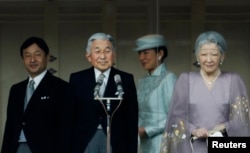Abdication by Japanese emperors is rare, the last coming in 1817 when Emperor Kokaku stepped down.
Emperor Akihito ascended to the throne following the 1989 death of his father, Emperor Hirohito, continuing a royal lineage that dates back hundreds of years.
But the emperor was the first to take over in a new era of a vastly diminished role under a new constitution following Japan's defeat in World War II. The document describes the emperor as "the symbol of the state and of the unity of the people" who derives his position from "the will of the people with whom resides sovereign power."
The change during Emperor Hirohito's time essentially demoted him from the status of a living god in a military dominated nation to a non-governing symbol. The emperor and his family now participate in ceremonies, host dinners and teas, receive dignitaries and visit different parts of Japan, including those hit by natural disasters.
The emperor refrains from commenting on the country's political matters.
Emperor Akihito
The 82-year-old emperor was a child during the war and was sent away from Tokyo during the conflict. Following the war, he visited dozens of countries as prince and in 1959 became the first member of the royal family to marry a commoner.
In recent years he has suffered from health problems, including prostate cancer and heart issues, which along with his advancing age have led to him cut back on his duties and delegate some to his eldest son, Crown Prince Naruhito. The emperor and his wife, Empress Michiko, have two other children.
He has acknowledged making some mistakes in his official duties and announced it will be difficult to fulfill them.
Crown Prince Naruhito
The 56-year-old prince is first in line to continue a royal lineage that the family dates to 660 B.C. His time as prince has included similar activities to those of his father, including visiting a number of foreign countries and taking on ceremonial duties at home.
Under the current system, the line of succession follows male heirs. The prince has been married since 1993 to Princess Masako, who was a commoner like the prince's mother, and the couple has one teenage daughter.
Princess Masako
The 52-year-old princess has kept a low and private profile, which she has in part attributed to struggles with stress. With the focus on male heirs, there was great public interest in the couple having a male child. The prince's brother, Prince Akishino, is the father of a son and two daughters.
The princess has a degree in economics from Harvard University and worked in Japan's foreign ministry before agreeing to marry the prince after a long courtship.








